How many bricks are in a pallet?
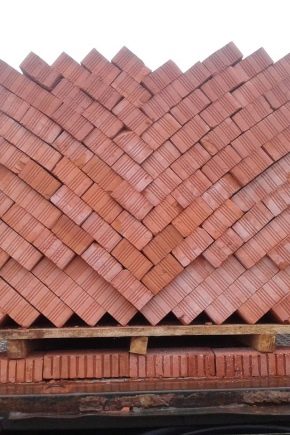
The need to clearly know how many bricks are in a pallet arises not only among professional builders. It is equally important to know the exact number of products per piece and for people doing work on their own. When calculating the consumption of materials per 1 m2 of masonry or 1 m3 of a wall, it is this indicator that determines the volume of purchases. The number of pieces and cubes of red facing and solid single bricks in 1 pallet depends on the method of stacking, the size of the pallet itself. Universal calculation formulas work only if these two variables are known.
Views
The varieties of single bricks transported in pallets or pallets are quite diverse. The following main categories are usually distinguished.
- Red - is made from natural clay, by passing molding and kiln firing. The finished product combines excellent strength characteristics, not too heavy weight - 3.6 kg for a full-bodied version, resistance to external weathering. The dimensions of the brick block are 215x12x6.5 cm.
- White - silicate, produced not from clay, but from quartz sand, the mass of which reaches 90% of the total volume. In addition, lime and various additives are present in the composition. The process of forming the product takes place by dry pressing, followed by processing of raw materials in an autoclave under steam action. Its high strength characteristics make it an attractive choice for finishing and cladding. But to lay out a stove or pipe made of white brick will not work - when heated over 200 degrees Celsius, it will simply burst.
- Fireclay. Refractory bricks for laying out stoves, fireplaces, chimneys are made from finely crushed chamotte, and special types of clay. It is produced in several of the most popular size ranges, depending on the brand, it can be transported on platforms of different sizes.
- Facing. It is produced in a hollow version, with a different pattern of recesses. Has standard dimensions 250x90x50 mm. There is also a yellow variety produced in both ceramic and clinker or hyper-pressed form. The size of one product in this case will be 250x120x65 mm.
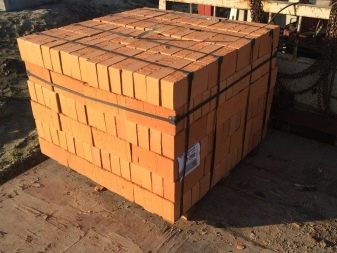
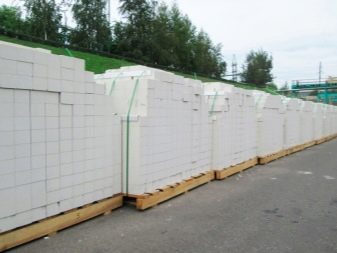
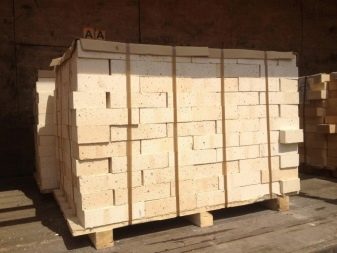
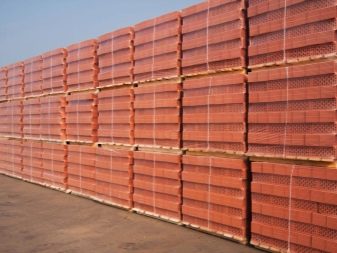
The types of pallets used when transporting bricks are also of great importance. For example, when it comes to the size range and carrying capacity, only two options are used in the transport sector. Standard pallets or pallets have a loading capacity of no more than 750 kg, with a platform size of 1030x520 mm. There are also reinforced options. In this case, the pallet has dimensions of 1030x770 mm and can withstand a weight of up to 900 kg. There are also Euro pallets used in the field of international transportation, and meeting the requirements of the standard GOST 9078-84. Their dimensions are 1200x800 mm, the maximum carrying capacity is 1500 kg. All products for transportation are made from natural wood, with bars as stiffeners.
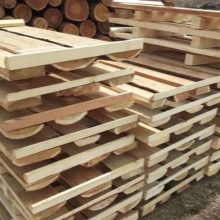
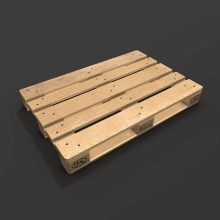
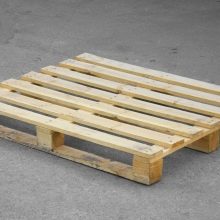
Capacity
Red
The capacity of bricks in a pallet, depending on the size of the product.
How many bricks are included in one pallet of regular size? Usually, the unit of measurement is taken as a pallet of 103x77 cm. In this case, in 1 stack per meter in height (standard), the amount of backing or ordinary material will be quite standard. You just need to clarify the specific parameters. For example, a hollow ceramic block will be placed on a large pallet in the amount of 420-480 pieces.On a small one it will fit from 308 to 352 pieces. Let's consider in more detail the data on the most popular types of bricks.
Solid brick type | 250x120x65 | 250x120x88 | worker | stove | basement | M100 | facing |
number of pcs. in a pallet 130x77 cm. | 420 | 390 | 200–400 | 420 | 420 | 420 | 360 |
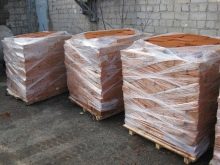

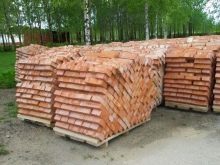
White
In a pallet of a standard size, the amount of white sand-lime bricks usually depends on what type of product is planned to be transported. It is worth adding that the platforms themselves will also be reinforced - due to the greater mass of the elements. On wood-metal pallets with dimensions 1915x600 mm or 1740x520 mm, 240-300 pieces are placed. single sand-lime brick. For a one-and-a-half product, this figure will be 350-380 pieces, but the manufacturer can also ship half-packs of 180 units. For the facing option, the number of bricks per pallet will be 670–700 pieces. For slotted - from 380 to 672 pcs. Hollow double bricks are placed on a special pallet in the amount of 448 units. All these indicators are relevant exclusively for packaged products. In its absence, the number of pieces of goods available for delivery will depend on the stacking method. But with such transportation, the volumes of damaged and broken building material will be much higher.

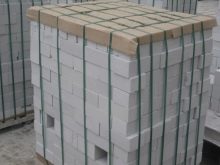
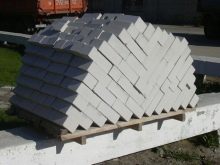
Shamotny
For kiln or fireclay blocks, the number of units per pallet is also of great importance. Here you should definitely pay attention to the product labeling. Among the most popular options are end wedges, which are placed on wooden pallets of 415 pcs. In addition, the brand ШБ-5, measuring 230x114x65 mm, is stacked and transported on pallets of 385 pcs. If you buy fireclay bricks ШБ-8, with dimensions of 250x124x65 mm, 625 pieces are stacked on a standard pallet. Standard standards are not the only correct ones, and it is imperative to take into account the dimensional characteristics of the selected pallet option. Fireclay bricks of any brand are placed in the maximum volume on a more spacious Euro pallet.

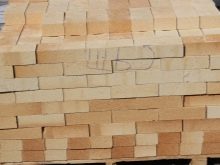
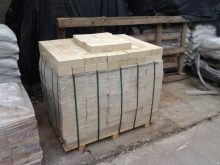
Facing
For facing bricks, the calculation of the number of products fit into the pallet also implies obtaining information based on the size of the product. With a standard size of 250x130x65 mm, 275 units of products are placed on the pallet. The single ceramic hollow body will fit 480 pcs. Silicate and yellow 200 pcs. in a single version. For the clinker variety, this figure will be 344 units. All specified data must be carefully checked, taking into account the standard according to which the product is manufactured, the carrying capacity of the pallet. In addition, when purchasing from a manufacturer, you need to clarify its individual parameters used during transportation. Only taking into account all these factors, it will be possible to accurately calculate the number of pallets and select the mode of transport for their delivery to the object.
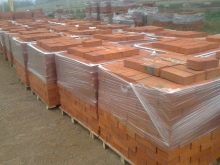
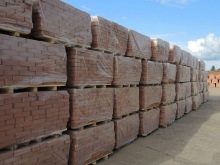
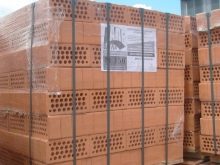
How many cubes and squares are in the pallet
When calculating the number of bricks that fit on a pallet, it is imperative to pay attention to other significant points. For example, if products are sold in cube. m, they need to be purchased taking into account the number of pallets used for transportation, and their capacity. In addition, when calculating the masonry, the wall area is calculated in sq. m. It is also possible to determine how many squares fit in a pallet by precise calculations. It is enough to specify the number of products per square meter based on the size of each element. It should also be remembered that the packaging of building bricks on pallets cannot have a stack height of more than 1 m.
Brick version | m2 on a standard 750 kg pallet | m3 on a standard pallet with a lifting capacity of 750 kg |
Ceramic corpulent single | 4 | 0,42 |
Ceramic corpulent one and a half | 5,1 | 0,47 |
Ceramic corpulent double | 7,6 | 0,45 |
Ceramic hollow single | 6,9–8,7 | 0,61 |
Ceramic hollow one-and-a-half | 7,3–8,9 | 0,62 |
Ceramic hollow double | 6,7–8,6 | 0,65 |

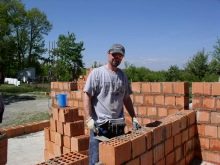
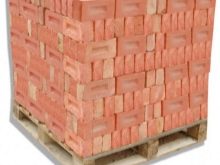
Total weight
The total weight of the pallet is also important. When choosing a freight transport, it is this aspect that needs to be taken into account, and not at all the net weight of the products.In particular, a small pallet 103x52 cm weighs 15 kg without loading. At the same time, the mass of bricks immersed on it can be up to 1017 kg - this is how much 275 pieces weigh. single solid silicate brick. If the pallet is not fully loaded, the weight can be obtained using simple calculations. The number of bricks is multiplied by the mass of one product:
Brick type | corpulent | hollow |
Ceramic | 3500 g | 2600 g |
Silicate | 3700 g | 3200 g |
A preliminary calculation of the required amount of bricks provides optimal opportunities for ordering building materials not individually or in bulk, but in convenient packaging, pallets. This approach is actively practiced in hardware stores and factories where products are manufactured. Having at your disposal the most accurate information, you can easily cope with the purchase of the required amount of bricks.
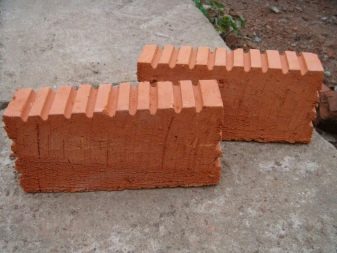
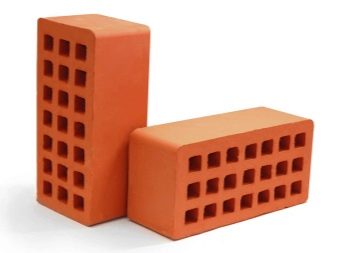
For more information on brick calculations, see the video below.













The comment was sent successfully.